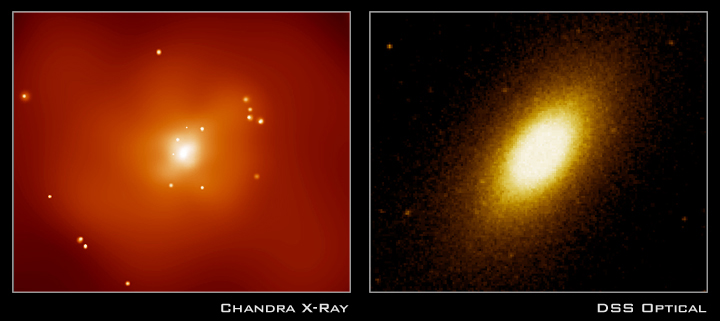
 Credit: X-ray: NASA/CXC/UCI/D.Buote et al., Optical: DSS U.K.Schmidt Image/STScI
Credit: X-ray: NASA/CXC/UCI/D.Buote et al., Optical: DSS U.K.Schmidt Image/STScI
MOND Unfound
Astronomers have known for some time
that the motions of galaxies usually do not follow the predictions of standard
gravitational theory if all the mass is contained in bright objects like stars.
Such discrepancies might suggest that the presence of large amounts of hidden,
"dark" matter. But what if gravity itself is at fault? Galactic motions could be
explained without "dark matter" if gravity on large distance scales behaves
differently than it does on the smaller distance scales that we're more familiar
with. One such theory that has had
some success in matching observations is
called "Modified Newtonian Dynamics" or MOND. A
recent observation by the Chandra X-ray
Observatory provides one of the most stringent tests of this theory. A
Chandra image (above
left) of the elliptical galaxy NGC 720 reveals a faint glow of X-ray emitting
matter around the galaxy. What's unusual is that the shape of the X-ray emitting
gas is much different than the optical image of the galaxy (shown in the image
on the right). The shape of this hot gas is difficult to reconcile with MOND,
and more consistent with the dark matter hypothesis.
Last Week *
HEA Dictionary * Archive
* Search HEAPOW
* Education
Each week the HEASARC
brings you new, exciting and beautiful images from X-ray and Gamma ray
astronomy. Check back each week and be sure to check out the HEAPOW archive!
Page Author: Dr. Michael F. Corcoran
Last modified October 27, 2002


